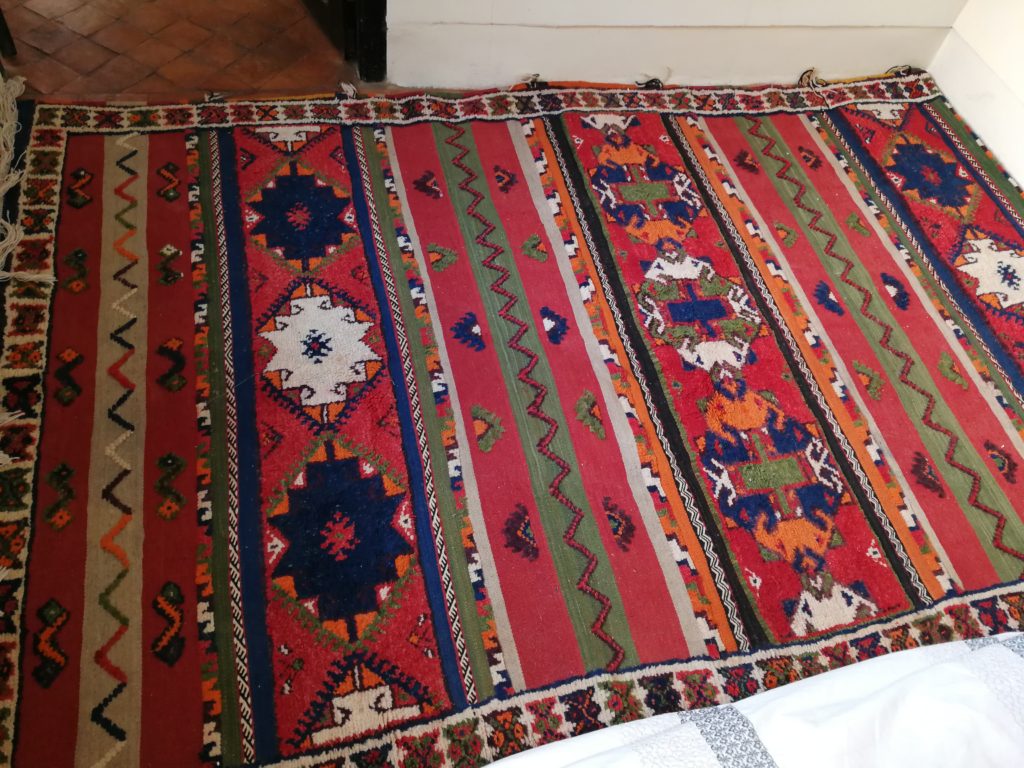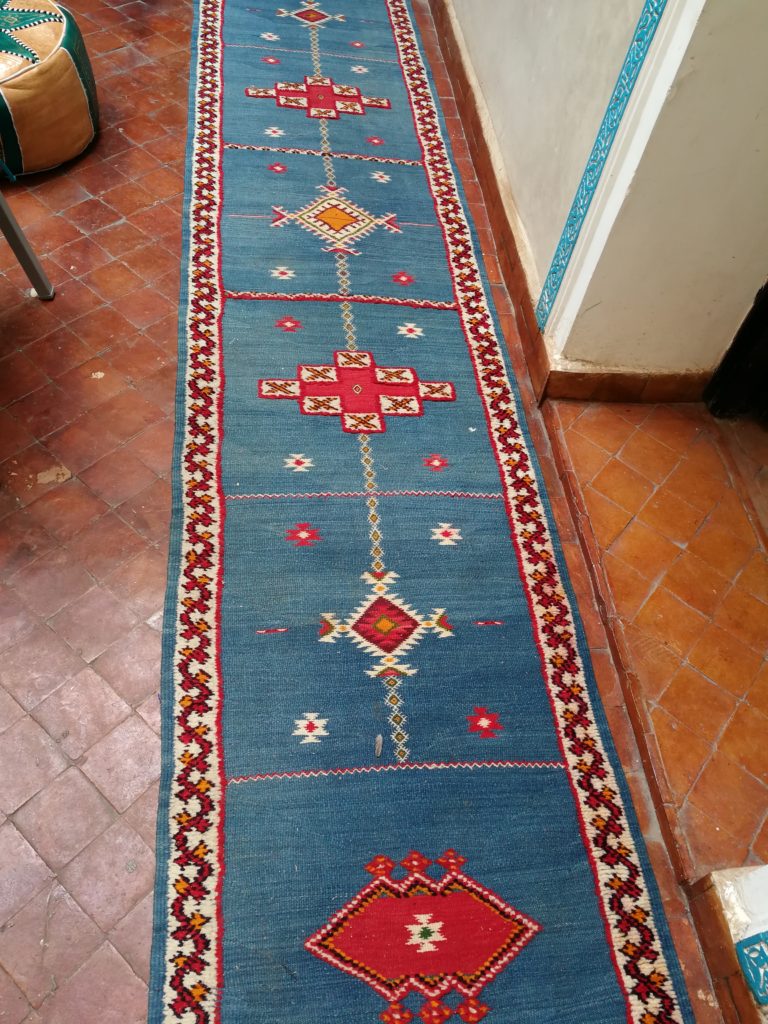One of the first things I fell in love with when I was in Marrakech were the Berber carpets. I found them simply intriguing and was drawn to them immediately!
Usually, the carpets are woven for household use, as a wedding gift to daughters or sons or to be sold at the markets. However, this ancient art which was traditionally passed down through the generations from mother to daughter is slowly disappearing. With education and modernisation, more girls go to school and such skills are sadly lost. To preserve this heritage, nowadays many cooperatives have been established for women to sell their carpets so that this ancient method of weaving will not be not lost.
What’s so special about a Berber carpet?
For me it’s the colours and motifs. The colours are so rich and striking – dark reds, indigo, saffron yellows and orange, turquoise and deep aquamarine blues. The motifs on the carpets evoke tribal symbolism and history that has persevered over the centuries. Each symbol has a meaning which the Berber woman has woven into the carpet to tell HER story. Furthermore, each individual carpet is hand woven and uniquely different from another. No two are the same and although it may be woven by the same woman, her life has moved on, circumstances have changed and she starts to tell another story in her life.
What do the symbols mean?
The symbols all have different meanings which are usually related to fertility, motherhood, marriage, prosperity, unity, blessings and warding off the evil eye. For example, the diamond is usually a symbol of femininity, fertility and womanhood.
Where do Berber carpets come from?
The carpets come from different Berber tribes in Morocco especially from the various regions in the Atlas Mountains. The most famous Berber carpets are from Azilal, Beni Ouarain, Zayane, Rehamna, Boujad and Mrirt.
There are also different types ranging from kilims which are thinner or thicker more plush ones like the carpets from Beni Quarain. For more information on the different types click here.
How is the colour made?
The colours used in authentic Berber carpets are made from natural dye; flowers and vegetation of the region. For example, orange and yellow from saffron, red from the Poppy flower, white from the natural wool of sheep, and blue from indigo. Some of the modern carpets use synthetic dyes but traditionally Berber carpets use natural dyes found in the surrounding environment.
Dos and Don’t for buying Berber carpets
- DO check whether the carpet is an original Berber carpet – good quality Berber carpets are made from 100% wool and natural dyes. How do you tell a synthetic carpet from one made from pure wool? Simple! With a cigarette lighter. Holding a flame under the tassels of a carpet will produce a very different result, depending on the material from which it is made. If it is natural wool, it won’t light up.
- DO check if it fits your cabin luggage? Make sure it is tightly packed and fits! If not you may have to pay access for extra luggage. Usually the carpet seller will back it for you.
- DO decide where you want to place it; in your living room, bedroom or hall? This will enable you to decide whether it suits the place in terms of colour, pattern or size. Are the patterns too crowded or messy, is it too small, big, too bright in colours?
- DON’T be scared to haggle. Depending on where you go, from my experience the Moroccans can over price their carpets up to 3-4x more than the actual price. So haggle hard, don’t show how much you really want the carpet (that’s hard to do when you’ve fallen in love with one!) The ones we have bought are less than 400 pounds each. But of course, the more vintage carpets will cost more, it’s really up to your budget how much you want to spend. A good measure is saying to yourself, how much would this cost in the UK or Europe, is it worth the price you are paying? Of course the carpet dealers will charm you with their mint tea and charming stories that they are hard to make, hand woven, and one of a kind but essentially you should ask yourself whether is it worth the money they are asking for. They can sometimes be intimidating, if you’re uncomfortable just firmly say no and leave. Guides take a commission of 30-40% so you’re paying more if you go with a guide.
- DON’T rush, take your time – buying a carpet should be an enjoyable experience where YOU should be in control and not the other way round. Don’t be pushed or feel obliged to buy if in the end the carpet is not quite what you want
Obviously Berber carpets will vary in price depending on quality, size, thickness and colours. For instance, the Beni Quarain carpets, because of their thickness and 100% wool are more expensive while the kilims which are thinner tend to be cheaper.
If you stay in Riad Farasha you will see many beautiful carpets. Most of them were bought in a shop along the way to the Ourika valley. We love every single one of them!
We have this in the Sapphire room, which is my favourite because of the gorgeous blue which is so unique.

This one is in the Ruby room, to match the reds in the room.

This one is in the Diamond room.

This is in the hall on the first floor.

On the ground floor we have this turquoise runner to match the turquoise colours of the riad.

And this one near the pool.

In the Topaz room, we have this beautiful one in tones of yellow and orange.

Tell us what you think, which is your favourite carpet in Riad Farasha?







Leave a Reply